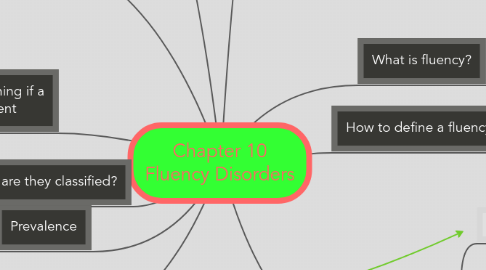
1. Stuttering
1.1. Developmental stuttering
1.1.1. When children begin stuttering between 2 and 5 years of age.
1.1.2. Stuttering like disfluencies (SLDs)
1.2. Neurogenic stuttering
1.2.1. When stuttering results from brain injury or neurological insult
1.3. Psychogenic stuttering
1.3.1. Occurs from psychological trauma
2. Prevalence
2.1. 1 in 100 persons and incidence rate of about 5 in 100 persons. About 5% of people have stuttered in their lives but only about 1% have a fluency disorder Boys are affected more than girls 3:1.
3. How are they classified?
3.1. By etiologies
3.1.1. Types of disorders by etiology
4. Preschoolers & Determining if a Fluency Disorder is present
4.1. Characteristics of 2 to 5 year olds with potential fluency disorder
4.1.1. 1. Core Behaviors 2. Secondary behaviors 3. Emergence of negative feelings and attitude about stuttering. (Avoidance of speaking when in a group or class)
5. Avoidance
5.1. Word or Sound Avoidance: An individual will avoid a word or phrase by substituting it for something else
5.2. Circumlocution- An individual will delay a potential disfluency by putting it off or talking around it.
5.3. Situation Avoidance: Person tries to avoid any situation where their stuttering can be problematic. Such as answering a phone, going shopping, ordering at a restaurant.
6. Causes and Risk Factors
6.1. Predisposing factors
6.2. Precipitating factors
7. What is fluency?
7.1. A descriptive term used to characterize the flow of speech during communication.
7.2. Disfluency: Speech behavior that disrupts the fluent forward flow of speech, such as pauses, interjections and revisions.
8. How to define a fluency disorder
8.1. Speech with an unusually high rate of stoppages that disrupt the flow of communication and are inappropriate for the speaker's age.
9. Features
9.1. Three types of dysfluencies (Core)
9.1.1. Prolongation
9.1.1.1. Refers to a sound being help longer than normal
9.1.2. Repetition
9.1.2.1. Occurs when a sound, syllable, or word is repeated several times to the point of interrupting the flow of speech
9.1.2.1.1. Part word repetition:Sound or syllable repeated. She is my ba-ba-ba-baby.
9.1.2.1.2. Single-syllable-word repetition: A single syllable word is repeated two or more times. My-my-my-my friend is here.
9.1.3. Block
9.1.3.1. Occurs when airflow and the articulatory movement completely stop during production of a sound; lasting as long as 5 seconds
9.2. Secondary features
9.2.1. May include; eye blinks, lip tremors, and head jerks, negative feelings and attitude
9.2.1.1. Escape & Avoidance Behaviors
9.2.1.1.1. An individual tries to escape or avoid a moment where they would be forced to speak and stutter.
9.3. Within-word disfluencies: Includes sound prolongations, repetitions and blocks.
9.3.1. Characterized by problematic speech behaviors, or stuttering.
9.4. Between word disfluencies: Occurs between rather than within words. Includes phrase repetitions, interjections and revisions.
10. Treatment
10.1. Children
10.1.1. Parent-implemented mostly and direct treatment from therapist
10.1.1.1. Stuttering modification: Goal is to make the stuttering less noticeable and less intense.
10.1.1.2. Fluency shaping: Help person produce clear/fluent speech more often, hoping to cut out the stuttering.
10.2. Adolescents
10.2.1. Suggestions to deliver treatment
10.2.1.1. Relaxation strategies and techniques
10.2.1.2. Improve the knowledge base about stuttering, causes and treatment
10.3. Adults
10.3.1. Knowledge about stuttering
10.3.2. Reduction of negative feelings
10.3.3. Fluency building
